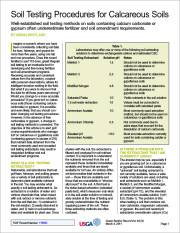Soil Testing Procedures for Calcareous Soils

Well-established soil testing methods on soils containing calcium carbonate or gypsum often underestimate fertilizer and soil amendment requirements.
BY BRIAN WHITLARK
Imagine a scenario where you have been consistently collecting soil data for tees, fairways, and greens for more than five years, using one lab and one procedure. Does this sound familiar to you? If it does, great! Regular soil testing is an invaluable tool for developing and fine-tuning fertilizer and soil amendment programs. Receiving accurate and consistent values from the laboratory, coupled with personal observations, allows for intelligent decision making in the field. But what if you were to discover that the data for all those years was wrong? Would you change to a more accurate procedure? If you grow turf on calcareous soils (those containing calcium carbonate) or gypsum, it is possible, and even likely, that you should consider changing soil testing procedures. However, in the absence of free carbonates or gypsum, a change in soil testing methods is unneeded. The objective of this article is to alert golf course superintendents who manage turf on calcareous or gypsiferous soils (containing gypsum in excess of 2%) that nutrient data obtained from the most commonly used and accepted soil testing extractants may result in misguided fertilizer and soil amendment programs.


